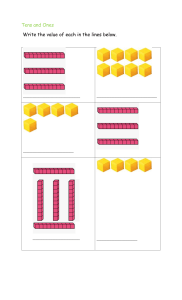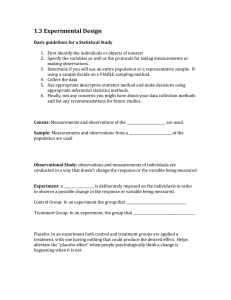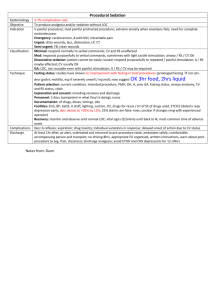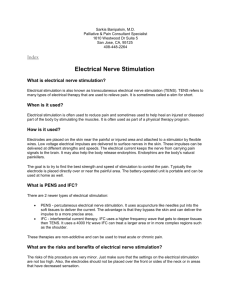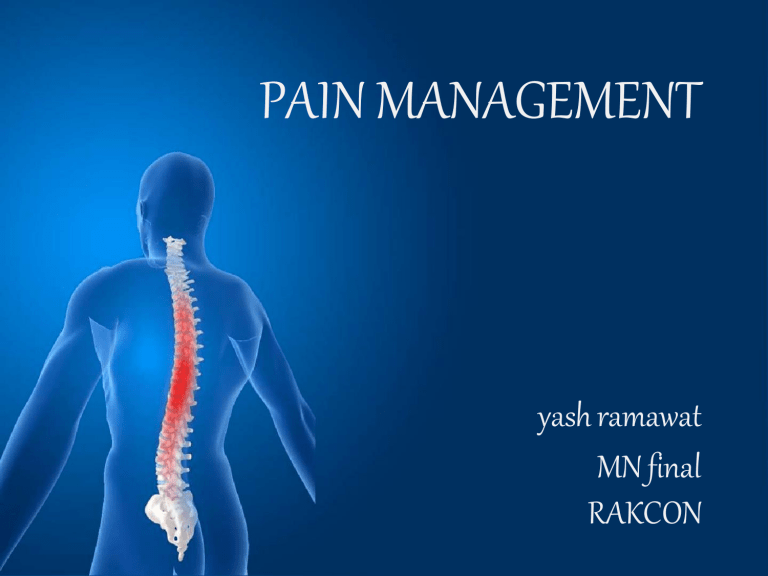
PAIN MANAGEMENT yash ramawat MN final RAKCON WHAT IS PAIN ? DEFINITIONS “PAIN” is defined as an unpleasant sensory and emotional experience arising from actual or potential tissue damage or described bin terms of such damage.(IASP)(mersskey&bogduk,1994). Margo Mc caffery(1968)first defined pain as whatever the person experiencing says it is,exiting it is whenever he says it is. Pain is subjective,protective,and it is modified by developemental,behavioural,personality andcultural factors. FIFTH VITAL SIGN TYPES OF PAIN CLASSIC CATEGORY • • • • NOCICEPTIVE NEUROPATHIC PAIN INTENSITY TIME COURSE physiology of pain TRANSDUCTION TRANSMISSION PERCEPTION MODULATION Modulation 3 2 1 Effects of pain Increased heart rate Diaphoresis increased blood glucose levels dilatation of pupils decreased GI motility increased musle tension increased respiratory rate THEORIES RELATED TO PAIN The Gate Control Theory • Proposed by Melzack and Wall in 1965 • Stimulation of the skin evokes nervous impulses • Stimulation of the large diameter fibers inhibits the transmission of pain, thus closing the gate SPECIFICITY THEORY • One of the earliest pain theory. • Proposed by Descartes in seventeenth century.(1664)Muler(1840). • Distinct pain receptors-free nerve endings in the tissue.with transmission by nerves directly to the brain. • Pain is purely an afferent sensory experience. PATTERN THEORY (INTENSITY THEORY) Goldschneider in 1896 and expanded by Weddell and Sinclair in 1947 Pattern of stimulation of nerve endings determines whether the brain would interpret stimuli as pain Attributes sensation of pain to pattern, or frequency and intensity of stimulation applied that excite touch, pressure, or temperature resources in the skin Biochemical Theories Biochemical Theories pain-producing, painmediating and pain chemoreceptors are located in the brain Endogenous opiates – inhibits pain by blocking substance P Periacquedactal gray area Chemical pain mediators and inhibitors Bradykinin e. acetylcholine Substance P f. capsaicin Histamine g. Potassium ions prostaglandin NURSING ASSESSMENT OF PAIN CHARACTERISTICS OF PAIN CHARACTERISTICS OF PAIN • • • • • • INTENSITY TIMING LOCATION QUALITY PERSONAL MEANING AGGRAVATING AND ALLEVIATING FACTORS • PAIN BEHAVIOURS INSTRUMENTS FOR ASSESSING PAIN PERCEPTION • VISUAL ANALOGUE SCALES(VAS) FACES PAIN SCALE THE NURSE’S ROLE IN PAIN MANAGEMENT • IDENTIFYING GOALS FOR PAIN MANAGEMENT • ESTABLISHING THE NURSE-PATIENT RELATIONSHIP AND TEACHING • PROVIDING PHYSICAL CARE • MANAGING ANXIETY RELATED TO PAIN PAIN MANAGEMENT STRATEGIES • Pain management strategies include both pharmacologic and nonpharmacologic approaches. • PHARMACOLOGIC INTERVENTIONS • NON-PHARMACOLOGIC INTERVENTIONS PHARMACOLOGIC INTERVENTIONS NON - PHARMACOLOGIC Non-pharmacological pain management is the management of pain without medications. This method utilizes ways to alter thoughts and focus concentration to better manage and reduce pain. Methods of nonpharmacological pain include: Superficial Heat Superficial heat can produce heating effects at a depth limited to between 1 cm and 2 cm. Deeper tissues are generally not heated owing to the thermal insulation of subcutaneous fat and the increased cutaneous blood flow that dissipates heat. It has been found to be helpful in diminishing pain and decreasing local muscle spasm. Superficial heat, such as the hydrocollator pack, should be used as an adjunct to facilitate an active exercise program. It is most often used during the acute phases of treatment when the reduction of pain and inflammation are the primary goals. Cryotherapy Cryotherapy can be achieved through the use of ice, ice packs, or continuously via adjustable cuffs attached to cold water dispensers. Intramuscular temperatures can be reduced by between 3 °C and 7 °C, which functions to reduce local metabolism, inflammation, and pain. Cryotherapy works by decreasing nerve conduction velocity, termed cold-induced neuropraxia, along pain fibers with a reduction of the muscle spindle activity responsible for mediating local muscle tone. It is usually most effective in the acute phase of treatment, though it can be used by patients after their physical therapy Exercise Correction of posture may be the simplest technique to relieve symptoms in patients with nonspecific neck or low back pain, though it is extremely difficult to change habits. The physician should instruct patients to assume their worst postural “slump position” with forward protrusion of the head, flexion of the neck, rounding of the shoulders, and increased thoracic kyphosis and reversed lumbar lordosis while sitting. Next, the physician should instruct patients to correct these postural abnormalities through retraction and extension of the head, retraction of the shoulders, extension of the thoracic spine, and return of the lumbar lordosis. TENS and PENS TENS and PENS stand for Transcutaneous Electrical Nerve Stimulation and Percutaneous Electical Nerve Stimulation respectively. Both procedures can be helpful in alleviating some of the more painful symptoms of peripheral neuropathy, but have to be used repeatedly to sustain the benefits. During TENS procedures, a small battery operated device is worn by the patient and electrodes are typically placed on the surface of the skin, over the area where the pain is felt. Low level electrical current is then applied for usually about thirty minutes, several times throughout the day. • The PENS procedure is similar in concept to TENS. The main difference is that instead of using the surface electrodes seen in TENS devices, PENS uses needle probes as electrodes that are inserted through the skin. These needle probes are typically placed next to the nerve causing painful neuropathy symptoms and then stimulated. PENS can be used in people who do not get sufficient pain relief from TENS ACUPUNCTURE Traditional Chinese acupuncture involves the insertion of extremely fine needles into the skin at specific "acupoints." This may relieve pain by releasing endorphins, the body's natural painkilling chemicals, and by affecting the part of the brain that governs serotonin, a brain chemical involved with mood.a cupuncture is generally quite safe, and the complication rate appears to be quite low. A review of acupuncture-related complications reported in medical journals found that the most serious problem was accidental insertion of a needle into the ACUPRESSURE acupressure points (also called potent points) are places on the skin that are especially sensitive to bioelectrical impulses in the body and conduct those impulses readily.Stimulating these points with pressure, needles, or heat triggers the release of endorphins, which are the neurochemicals that relieve pain. As a result, pain is blocked and the flow of blood and oxygen to the affected area is increased. This causes the muscles to relax and promotes healing. Because acupressure inhibits the pain signals sent to the brain through a mild, fairly painless stimulation, it has been described as closing the "gates" of the pain-signaling system, preventing painful sensations from passing through the spinal cord to the brain.Besides relieving pain, acupressure can help rebalance the body by dissolving tensions and stresses that keep it from functioning smoothly and that inhibit the immune system. Acupressure enables the body to adapt to environmental changes and resist illness. Placebo therapy • It is the use of the substance or procedure without specific activity for the condition that is trying to be healed. It was found that placebo induced analgesia depends on the release of endogenous opiates in the brain and that the placebo effect can be undone using the opiates antagonist naloxone. Functional magnetic resonance imaging of the brain showed that placebo analgesia was obtained regarding the activation and increased functional relationship between ant. Placebo effect can be achieved in several ways: by using pharmacological preparations or simulation of operating or other procedures. This phenomenon is associated with perception and expectation of the patient. To achieve the effect of placebo it is essential degree of the suggestions of the person who prescribe a placebo, and the degree of belief of the person receiving the placebo. Expected effect of placebo is to achieve the same effect as the right remedy. Achieved placebo effect depends on the way of presentation. If a substance is presented as harmful, it may cause harmful effects, called 'nocebo" effect. Placebo effect is not equal in all patients, same as the real effect of the drug is not always equal in all patients. CUTANEOUS STIMULATION AND MASSAGE. • The gate control theory of pain proposes that stimulation of fibres that transmit nonpainful sensations can block or decrease the transmission of pain impulses. • Massage, which is generalized cutaneous stimulation of the body promotes comfort through muscle relaxation. DISTRACTION • It helps to relieve both acute & chronic pain. • It involves focusing the patient’s attention on something other than the pain. • Distraction techniques may eb watching TV or listening to music etc. RELAXATION TECHNIQUES. It reduces pain by relaxing tense muscles that contribute the pain. Techniques consists of abdominal breathing at a slow, rhythmic rate. BED REST The use of prolonged bed rest in the treatment of patients with neck and low back pain and associated disorders is without any significant scientific merit. Bed rest supports immobilization with its deleterious effects on bone, connective tissue, muscle, and psychosocial well-being. For severe radicular symptoms, limited bed rest of less than 48 hours may be beneficial to allow for reduction of significant muscle spasm brought on with upright activity. Patients should be instructed to avoid resting with the head in a hyperflexed or extended position. The proactive approach emphasizes activity modification as opposed to bed rest and immobilization MANIPULATION AND MOBILIZATION Manipulative treatment is commonly used in the treatment of patients with neck pain and associated disorders. Many different types of manual treatment exist, including soft tissue myofascial release, muscle energy/contract-relax, and high-velocity low-amplitude manipulation. Soft tissue myofascial release may include various techniques, including effleurage, pétrissage, friction, and tapotement. It has been shown to improve flexibility, decrease the perception of pain, and decrease the levels of stress hormones. Traction • Cervical traction is a therapeutic modality that can be administered with the patient in the supine or seated position. Traction may reduce neck pain and works through a number of mechanisms including passive stretching of myofascial elements, gapping of facet joints, improving neural foraminal opening, and reducing cervical disc herniation. It has been found to reduce radicular symptoms in individuals with confirmed radiculopathy and localized neck pain in individuals with cervicogenic pain and spondylosis. Cervical traction may be initiated during physical therapy with the patient properly instructed in home use. It is not a stand-alone treatment modality and should be done in conjunction with range-of-motion (ROM) exercises, appropriate strengthening, and correction of postural issues. • EVALUATING PAIN MANAGEMENT STRATEGIES • After interventions, nurse asks the patient to rate the intensity of pain. The nurse repeats this assessment at appropriate intervals after the intervention and compares the result with the previous rating. These assessments indicate the effectiveness of pain relief measures and provides a basis for continuing or modifying the plan of care. ANALGESIA AND SEDATION IN CRITICALLY ILL PATIENTS • In critically ill patients, adequate analgesia and sedation increase comfort, reduce stress response and facilitate diagnostic and therapeutic procedures. Analgesia and sedation may also have a beneficial impact on morbidity, particularly by reducing pulmonary complications such as atelectasis and pneumonia, and delirium or agitation with subsequent accidental extubation. The method and depth of analgesia and sedation should be adapted to the needs of the individual patient. While evaluation of analgesia and sedation is important, technical tools for assessment are generally unreliable. GOALS OF SEDATION IN THE ICU • • • • • • • • Patient comfort Control of pain Anxiolysis and amnesia Adverse autonomic and hemodynamic responses Facilitate nursing management Facilitate mechanical ventilation Avoid self extubation Reduce oxygen consumption CHARACTERISTICS OF AN IDEAL SEDATION AGENTS FOR THE ICU • Lack of respiratory depression • Rapid onset, titratable with a short elimination half-time • Sedation with ease of orientation and arousability • Anxiolytic • Hemodynamic stability • No accumulation in renal/ hepatic dysfunction

